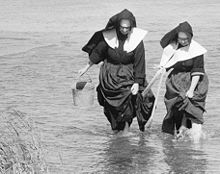

This article needs additional citations for verification. Please help improve this articlebyadding citations to reliable sources. Unsourced material may be challenged and removed.
Find sources: "Clam digging" – news · newspapers · books · scholar · JSTOR (November 2012) (Learn how and when to remove this message) |




Clam digging is a North American term for a common way to harvest clams (edible infaunal bivalve mollusks) from below the surface of the tidal sand flats or mud flats where they live. It is done both recreationally (for enjoyment or as a source of food) and commercially (as a source of income). Commercial digging in the U.S. and Canada is colloquially referred to as clamming, and is done by a clammer.[1]
Amateur clam digging is often done using a straight long-handled spading fork, or a spading shovel.
Commercial clamming for quahog clams, and the larger surf clams (soup clams) is primarily done offshore, via mechanical dredging. To harvest cultivated clam beds, aquaculturists often use a much smaller version (hand pulled) from the offshore dredge. Another form of commercial clamming is done from a flat-decked boat using a clam rake with a telescopic handle. The head of these rakes have long tines attached to a "basket-like" cage in which the clams are collected.
In the Minas Basin area of Nova Scotia, digging for soft-shelled clams is usually done with a clam hack, a spading fork with its short handle bent perpendicularly away from the fork's head. A digger typically uses the hack by grasping the spine of the prongs in one hand and the handle of the fork in the other to push the hack down into the mud, clay, or sand and then pull it up and towards him/herself. This digging action opens up the substrate to expose the clams. Those clams legally long enough (44 mm or 1.7 in in Nova Scotia) are then taken by hand and put into a peck-size (9 litre) bucket that is used to measure the volume of clams collected.
Clam digging on the New England coast is done using a "clam hoe" (a pitchfork with the handle cut off about 18 in or 460 mm from the tines then bent about 70 degrees) and a "hod" or "roller" (a half bushel basket built using wood lathes or wire mesh) and hip waders (boot that extend up to the top of the legs).[2] The use of other tools is prohibited in some areas.[3][4]
Another popular method for bay clamming is the use of specialized tongs from a boat. Operators use the long tongs to probe the sand for clams. Clam tongs appear very much like two clam rakes with teeth hinged like scissors.[5]
Digging for razor clams using a clam shovel or tube is a family and recreational activity in Oregon and Washington state.[6][7][8]
![]() Media related to Clam digging at Wikimedia Commons
Media related to Clam digging at Wikimedia Commons
|
Fishing equipment and methods
| ||||||||||||||||||||||||||||
|---|---|---|---|---|---|---|---|---|---|---|---|---|---|---|---|---|---|---|---|---|---|---|---|---|---|---|---|---|
| ||||||||||||||||||||||||||||
| ||||||||||||||||||||||||||||
|
| ||
|---|---|---|
| Fisheries |
| |
| Fishing |
| |
| Industry |
| |
| Recreation |
| |
| Techniques |
| |
| Tackle |
| |
| Locations |
| |
| ||